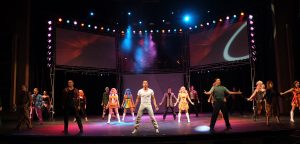High on decibels, low on laughs, Moonlight takes risk with The Who’s TOMMY
“I don’t get it.”
“Why is it so loud?”
“Why won’t the boy talk?”
More than a few will not “get” the music, the heat, or the story behind The Who’s TOMMY at Moonlight Amphitheater, but not because it’s an unknown or lacks visceral power.
Director/choreographer John Vaughan’s edgy show features a tight rock band on a raised loft above the stage. They conjure Pete Townshend’s elaborate orchestrations, and the powerful sound system will clean your clock. Acoustic guitar and horn are especially clean. A multi-talented cast sounds terrific, especially as a full chorus. You know the songs from classic rock radio – “Pin Ball Wizard,” “Sensation,” and “I’m Free” – and that’s a good thing.
With only a word or two of dialogue, it’s driven entirely by lyrics. So it doesn’t help that this often thrilling production is marred by muddy diction. An uneven sound mix made it very difficult to understand the words on opening night, but that will be remedied over the run.
Unlike the warm and fuzzy Wizard of Oz about a sweet farm girl who rides a tornado over the rainbow (a show that broke all attendance records at Moonlight this summer), the rock opera Tommy about a “deaf, dumb, and blind” pinball wizard is far from family fun. The story is so bizarre, that it’s hard to take seriously. Then again, the story smacks of grim realities.
I’m guessing that the woman who walked out at intermission gripping her cane didn’t appreciate the story of a 4-year-old English boy who goes catatonic when he witnesses a murder. She wanted no part of the freaky fable about sexual molestation, bullying, and a drug crazed prostitute hired to cure the boy.
She didn’t give a rat’s ass that 21 years ago Des McAnuff launched the rock musical at La Jolla Playhouse, or that it hit Broadway and won a bunch of Tony Awards. Let’s assume she was never a fan of revered guitarist Pete Townshend, known for writing the exhilarating music and semi-autobiographical lyrics, and smashing his guitars on stage.
She probably never played his celebrated concept album in her basement with a dope-smoking brother in 1969. And let’s assume she never saw Ken Russell’s 1975 psychedelic film version with a curly-haired Roger Daltrey as Tommy, and sex kitten Ann Margret as his mother, Mrs. Walker. An unforgettable scene has Margret smash a mirror and slither in a sea of champagne, beans, and chocolate.
Director/choreographer John Vaughan’s ambitious production does not include the slithering scene – now that would be visceral. He grabs the subtext of the film, but sticks to McAnuff’s staging. The focus is on Tommy’s journey from victim back to wellness, and forgiveness, but viewers have to wait for resolution.
Vaughan makes clever use of video projections and stripped down staging. I’ve never seen so many floating doors, and I love the scene where paratroopers leap and disappear in a trap door. Props and slides suggest time and place. Two giant hypodermic needles in the Acid Queen’s dance are sanitized compared to the haute cinema film. In the film, Daltrey is locked in a dosing coffin with dozens of needles that plunge into his flesh. What needles have to do with dropping acid is curious. Film buffs will also remember that in Russell’s film version, he has the boyfriend kill the dad, thereby making Tommy suffer with his mom’s new guy.
[php snippet=1]
Vaughan stays true to the stage versions. Tommy, a sweet little boy, loses his dad to war, only to witness him kill his mom’s boyfriend. Dad is acquitted, but Tommy is damaged. He suffers molestation and abuse by family members, medical tests, and bizarre encounters with an Acid Queen.
He finally becomes the pinball wizard. A metaphor for a rock star back in the day, Tommy can now be seen as a modern day pop star, think Justin Bieber stalked by groupies and surrounded by dangerous body guards.
The sharpest timing comes during scenes where doctors and nurses probe and test the poor kid. Groovy dances and rich vocals give breadth to the vague and violent narrative. Costumes start out black and white and explode into wild hippie colors and prints in the second act.
Eddie Egan is a clean shaven adult Tommy, the “sensation” in white jeans, and he sings with passion and guides his younger self (played by strong young actors Josh Bradford and Liam Brandt) on a freaky journey in and out of a mirror.
As the screwed up parents, Jason Webb plays Capt. Walker with manly aggression, and Misty Cotton is a suffering Mrs. Walker, angry and manic, though hardly the sex fiend character burned to memory by Margret in the film.
Standouts are Mark Bartlett, as sadistic Cousin Kevin, and Paul Morgavo, as wicked Uncle Ernie, both in fine voice and despised characterizations. Bartlett delivers his despicable portrayal in tight leather pants along with the bullying Local Lads, and Morgavo is stellar and frightening in the song “Fiddle About.” The scene with a bed and groping hands swirling is very disturbing and will make any normal human being squirm.
Anise Ritchie poured into a golden net costume has a splendid turn as the raspy and full-voiced Acid Queen, the role made famous by Tina Turner in the film. Chelsea Emma Franko is also memorable in the small, yet intriguing role of Sally, Tommy’s hysterical stalker fan.
The most familiar songs from Townshend’s album are infectious and harmless. We’ve been singing along without a worry for decades. Still, in trying to broaden its audience, Moonlight is taking a risk on TOMMY.
Plot shifts have softened the tone from the film. Dance ensembles and classic rock satisfy. Be warned though, it remains a rock opera stage revival about a kid, designed for adults. The best approach is to view it as an historic sensory blitz. Push the weird, even sickening storyline to the side. Just take it as a rock and roll blast from the past that marks time.
Revisit memories of TOMMY lyrics:
http://www.myths.com/pub/lyrics/Who_3_tommy.html

Kris Eitland covers dance and theater for Sandiegostory.com and freelances for other publications, including the Union Tribune and Dance Teacher Magazine. She grew up performing many dance styles and continued intensive modern dance and choreography at the Univ. of Minnesota, Duluth, and San Diego State Univ. She also holds a journalism degree from SDSU. Her career includes stints in commercial and public radio news production.
Eitland has won numerous Excellence in Journalism awards for criticism and reporting from the San Diego Press Club. She has served on the Press Club board since 2011 and is a past president. She is a co-founder of Sandiegostory.com. She has a passion for the arts, throwing parties with dancing and singing, and cruising the Pacific in her family’s vintage trawler. She trains dogs, skis, and loves seasonal trips to her home state of Minnesota.


What I describe as a “dosing cabinet” is better known as an “iron maiden – a torture device, consisting of an iron cabinet with a hinged front and spike-covered interior, sufficiently tall to enclose a human being” that may be fictional. Thank you, Christian.
CORRECTION
Uncle Ernie was played by Paul Morgavo.